Did the COVID-19 Pandemic Lockdown Harm Pre-Schoolers Learning in Portugal? Yes, but with Variations Depending on Socio-Economic Status
Abstract
1. Introduction
1.1. Pandemic Measures School Achievement and Socio-Economic Status
1.2. Early Child Education and Its Importance
1.3. The Lockdowns in Portugal
1.4. Purpose
2. Materials and Methods
2.1. Study Sample
2.2. Materials
2.2.1. Assessment Protocol and Performance Tasks
2.2.2. Other Measures—Graffar Index (GI) and Quiet Space to Study
2.3. Data Analysis
Variables Systematization
- -
- Time (4 years of assessment 2018–2022, 1 each year at the beginning of the grade 1).
- -
- SES (measured by Graffar Index).
- -
- QPS (presence or absence of a quiet place to study).
- -
- Vowel Identification (drawing and distinguishing some vowels on a card with a set of twenty randomly distributed capital letters).
- -
- Story Sort (listening to a short story—112 words—and retelling the story by placing cards with images representing the story into a coherent sequence).
- -
- Ranking Task (a card with four elephants of differentiated sizes and the children had to link the elephants in order from the smallest to the largest).
- -
- Counting (naming the number of blackberries in an image).
- -
- Figure Copying (copying the figures onto a sheet of paper, respecting the approximate shape and position so that the figures were recognizable).
- -
- Balance (walking along a straight line drawn on the floor without significantly deviating or needing adult support).
3. Results
3.1. Pre-Literacy
3.1.1. Vowel Identification
3.1.2. Story Sort
3.2. Maths
3.2.1. Ranking Task
3.2.2. Counting
3.3. Motor Skills
3.3.1. Figure Copying
3.3.2. Balance
4. Discussion
5. Conclusions and Recommendations
Author Contributions
Funding
Institutional Review Board Statement
Informed Consent Statement
Data Availability Statement
Acknowledgments
Conflicts of Interest
References
- George, G.; Dilworth-Bart, J.; Herringa, R. Potential socioeconomic effects of the CoViD-19 pandemic on neural development, mental health, and K-12 educational achievement. Policy Insights Behav. Brain Sci. 2021, 8, 111–118. [Google Scholar] [CrossRef]
- Hammerstein, S.; König, C.; Dreisörner, T.; Frey, A. Effects of COVID-19-Related School Closures on Student Achievement-A Systematic Review. Front. Psychol. 2021, 12, 746289. [Google Scholar] [CrossRef] [PubMed]
- Maldonado, J.E.; De Witte, K. The effect of school closures on standardised student test outcomes. Br. Educ. Res. J. 2021, 48, 49–94. [Google Scholar] [CrossRef]
- Poletti, M. Hey teachers! Do not leave them kids alone! Envisioning schools during and after the coronavirus (COVID-19) pandemic. Trends Neurosci. Educ. 2020, 20, 100140. [Google Scholar] [CrossRef] [PubMed]
- Kuhfeld, M.; Soland, J.; Tarasawa, B.; Johnson, A.; Ruzek, E.; Liu, J. Projecting the Potential Impact of COVID-19 School Closures on Academic Achievement. Educ. Res. 2020, 49, 549–565. [Google Scholar] [CrossRef]
- Haeck, C.; Lefebvre, P. Pandemic school closures may increase inequality in test scores. Can. Pub. Policy 2020, 46, 82–87. [Google Scholar] [CrossRef]
- Engzell, P.; Frey, A.; Verhagen, M.D. Learning loss due to school closures during the COVID-19 pandemic. Proc. Natl. Acad. Sci. USA 2021, 118, e2022376118. [Google Scholar] [CrossRef] [PubMed]
- Van Bakel, H.; Bastiaansen, C.; Hall, R.; Schwabe, I.; Verspeek, E.; Gross, J.J.; Roskam, I. Parental burnout across the globe during the COVID-19 pandemic. Int. Perspect. Psychol. 2022, 11, 141–152. [Google Scholar] [CrossRef]
- Lerkkanen, M.K.; Pakarinen, E.; Salminen, J.; Torppa, M. Reading and math skills development among Finnish primary school children before and after COVID-19 school closure. Read. Writ. 2022. [Google Scholar] [CrossRef]
- Engzell, P.; Frey, A.; Verhagen, M.D. Learning Inequality during the COVID-19 Pandemic; Center for Open Science: Charlottesville, VI, USA, 2020. [Google Scholar] [CrossRef]
- Andrew, A.; Cattan, S.; Costa Dias, M.; Farquharson, C.; Kraftman, L.; Krutikova, S.; Sevilla, A. Inequalities in children’s experiences of home learning during the COVID-19 lockdown in England. Fisc. Stud. 2020, 41, 653–683. [Google Scholar] [CrossRef]
- Van Dorn, A.; Cooney, R.; Sabin, M. COVID-19 Exacerbating Inequalities in the US. Lancet 2020, 395, 1243–1244. [Google Scholar] [CrossRef]
- Haelermans, C.; Korthals, R.; Jacobs, M.; de Leeuw, S.; Vermeulen, S.; van Vugt, L.; de Wolf, I.; van Wetten, S.; van der Velden, R.; Prokic-Breuer, T.; et al. Sharp increase in inequality in education in times of the COVID-19-pandemic. PLoS ONE 2022, 17, e0261114. [Google Scholar] [CrossRef] [PubMed]
- Alexander, K.L.; Entwisle, D.R.; Olson, L.S. Lasting consequences of the summer learning gap. Am. Sociol. Rev. 2020, 72, 167–180. [Google Scholar] [CrossRef]
- Pensiero, N.; Kelly, A.; Bokhove, C. Learning Inequalities during the Covid-19 Pandemic: How Families Cope with Home-Schooling; University of Southampton Research Report 1; Southampton Education School, University of Southampton: Southampton, UK, 2020. [Google Scholar]
- Lewis, K.; Kuhfeld, M.; Ruzek, E.; McEachin, A. Learning during COVID-19: Reading and math achievement in the 2020–21 school year. NWEA Brief 2021. Available online: https://www.nwea.org/content/uploads/2021/07/Learning-during-COVID-19-Reading-and-math-achievement-in-the-2020-2021-school-year.research-brief-1.pdf (accessed on 14 July 2021).
- UNESCO. International Standard Classification of Education (ISCED, 2011). 2012. Available online: http://uis.unesco.org/sites/default/files/documents/international-standard-classification-of-education-isced-2011-en.pdf (accessed on 12 July 2022).
- Douglass, A. Leadership for Quality Early Childhood Education and Care; OECD Education Working Papers, No. 211; OECD Publishing: Berlin, Germany, 2019. [Google Scholar]
- OECD. Early Childhood Education: Equity, Quality and Transitions; Report for the G20 Education Working Group; OECD: Paris, France, 2020. [Google Scholar]
- Vilarinho, E. The Rights of Children to Quality of Public Preschool Education: Critical Analysis of the Implementation of Inte-grated System of Child Education and care in Portugal. Rev. Pedagógica 2013, 15, 281–300. [Google Scholar] [CrossRef]
- UNICEF. A World Ready to Learn: Prioritizing Quality Early Childhood Education. 2019. Available online: https://doi.org/www.unicef.org/media/57926/file/A-world-ready-to-learn-advocacy-brief-2019.pdf (accessed on 14 July 2022).
- Denham, S.A.; Bassett, H.H.; Zinsser, K.; Wyatt, T.M. How preschoolers’ social–emotional learning predicts their early school success: Developing theory-promoting, competency-based assessments. Infant Child Dev. 2014, 23, 426–454. [Google Scholar] [CrossRef]
- Ten Braak, D.; Lenes, R.; Purpura, D.J.; Schmitt, S.A.; Størksen, I. Why do early mathematics skills predict later mathematics and reading achievement? The role of executive function. J. Exp. Child Psychol. 2022, 214, 105306. [Google Scholar] [CrossRef]
- Stites, M.L.; Sonneschein, S.; Galczyk, S.H. Preschool parents’ views of distance learning during COVID-19. Early Educ. Dev. 2021, 32, 923–939. [Google Scholar] [CrossRef]
- Pombo, A.; Luz, C.; de Sá, C.; Rodrigues, L.P.; Cordovil, R. Effects of the COVID-19 Lockdown on Portuguese Children’s Motor Competence. Children 2021, 8, 199. [Google Scholar] [CrossRef] [PubMed]
- Oliveira, L.; Mesquita, A.; Sequeira, A.; Oliveira, A. Emergency Remote Learning during COVID-19: Socio-educational impacts on Portuguese students. In International Conference on Interactive Collaborative Learning; Springer: Cham, Switzerland, 2020; pp. 303–314. [Google Scholar]
- Henriques, S.; Correia, J.D.; Dias-Trindade, S. Portuguese Primary and Secondary Education in Times of COVID-19 Pandemic: An Exploratory Study on Teacher Training and Challenges. Educ. Sci. 2021, 11, 542. [Google Scholar] [CrossRef]
- Portuguese Government. Comunicado do Conselho de Ministros de 11 de março de 2021. Available online: https://www.portugal.gov.pt/pt/gc22/governo/comunicado-de-conselho-de-ministros?i=407 (accessed on 14 July 2022).
- Von Holle, A.; North, K.E.; Gahagan, S.; Burrows, R.A.; Blanco, E.; Lozoff, B.; Voruganti, V.S. Sociodemographic predictors of early postnatal growth: Evidence from a Chilean infancy cohort. BMJ Open 2020, 10, e033695. [Google Scholar] [CrossRef] [PubMed]
- OCEP. Orientações Curriculares para a Educação Pré-Escola. Direção Geral de Educação. Républica Portuguesa 2016. Available online: http://www.dge.mec.pt/ocepe/ (accessed on 14 July 2022).
- Goudeau, S.; Sanrey, C.; Stanczak, A.; Manstead, A.; Darnon, C. Why lockdown and distance learning during the COVID-19 pandemic are likely to increase the social class achievement gap. Nat. Hum. Behav. 2021, 5, 1273–1281. [Google Scholar] [CrossRef] [PubMed]
- Özdemir, S.M.; Gündoğan Önderöz, F. Teachers’ Opinions on Teaching Primary Reading and Writing through Distance Education During the COVID-19 Pandemic Period. J. Teach. Educ. Lifelong Learn. 2022, 4, 34–50. [Google Scholar] [CrossRef]
- Schult, J.; Mahler, N.; Fauth, B.; Lindner, M.A. Did students learn less during the COVID-19 pandemic? Reading and mathematics competencies before and after the first pandemic wave. Sch. Eff. Sch. Improv. International Journal of Research, Policy and Practice Int. J. Res. Policy. Pract. 2022, 10, 1–20. [Google Scholar] [CrossRef]
- Darragh, L.; Franke, N. Lessons from Lockdown: Parent Perspectives on Home-learning Mathematics During COVID-19 Lockdown. Int. J. Sci. Math. Educ. 2022, 20, 1521–1542. [Google Scholar] [CrossRef]
- Lek, K.; Feskens, R.; Keuning, J. The effect of distance education on learning results in primary education Cito, Enschede, The Report 2020, Cito, Nov. Available online: https://www.cito.nl/-/media/files/kennis-en-innovatie-onderzoek/201104_cito_onderzoeksrapport-effect-afstandsonderwijs.pdf?la=nl-nl (accessed on 4 November 2020).
- Chambonnière, C.; Fearnbach, N.; Pelissier, L.; Genin, P.; Fillon, A.; Boscaro, A.; Bonjean, L.; Bailly, M.; Siroux, J.; Guirado, T.; et al. Adverse Collateral Effects of COVID-19 Public Health Restrictions on Physical Fitness and Cognitive Performance in Primary School Children. Int. J. Environ. Res. Public Health 2021, 18, 11099. [Google Scholar] [CrossRef] [PubMed]
- Kaffenberger, M. Modelling the long-run learning impact of the Covid-19 learning shock: Actions to (more than) mitigate loss. Int. J. Educ. Dev. 2021, 81, 102326. [Google Scholar] [CrossRef] [PubMed]
- Neville, H.J.; Stevens, C.; Pakulak, E.; Bell, T.A.; Fanning, J.; Klein, S.; Isbell, E. Family-based training program improves brain function, cognition, and behavior in lower socioeconomic status preschoolers. Proc. Natl. Acad. Sci. USA 2013, 110, 12138–12143. [Google Scholar] [CrossRef] [PubMed]
- Meeter, M. Primary school mathematics during the COVID-19 pandemic: No evidence of learning gaps in adaptive practicing results. Trends Neurosci. Educ. 2021, 25, 100163. [Google Scholar] [CrossRef] [PubMed]
- VanLehn, K. The relative effectiveness of human tutoring, intelligent tutoring systems, and other tutoring systems. Educ. Psychol. 2011, 46, 197–221. [Google Scholar] [CrossRef]
- Lucas, M.; Bem-Haja, P.; Siddiq, F.; Moreira, A.; Redecker, C. The Relation between In-Service Teachers’ Digital Competence and Personal and Contextual Factors: What Matters Most? Comput. Educ. 2021, 160, 104052. [Google Scholar] [CrossRef]
- Gamage, K.A.A.; Gamage, A.; Dehideniya, S.C.P. Online and Hybrid Teaching and Learning: Enhance Effective Student Engagement and Experience. Educ. Sci. 2022, 12, 651. [Google Scholar] [CrossRef]
- Remer, J.; Croteau-Chonka, E.; Dean, D.C., III; D’Arpino, S.; Dirks, H.; Whiley, D.; Deoni, S.C. Quantifying cortical development in typically developing toddlers and young children, 1–6 years of age. Neuroimage 2017, 153, 246–261. [Google Scholar] [CrossRef]

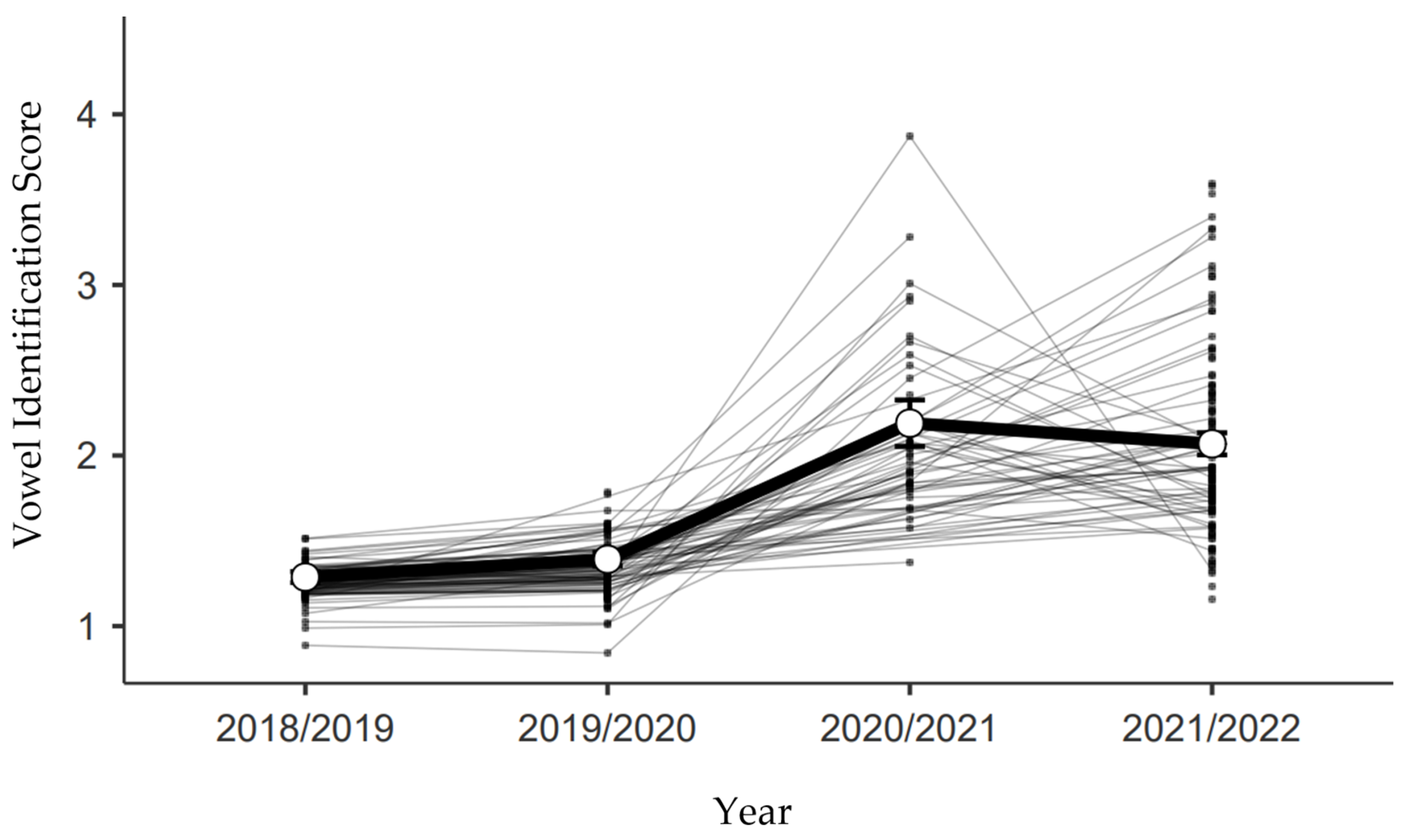
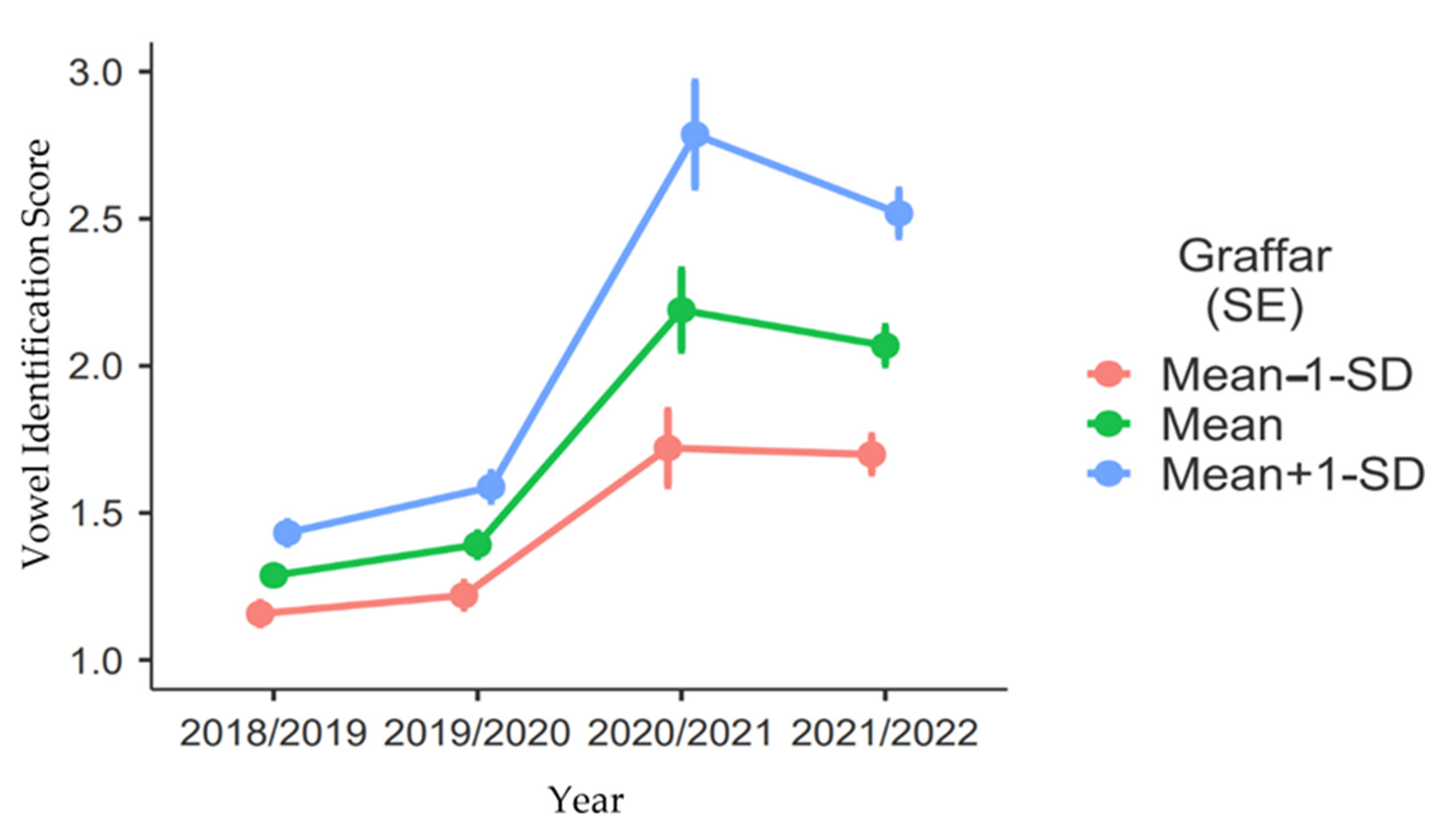
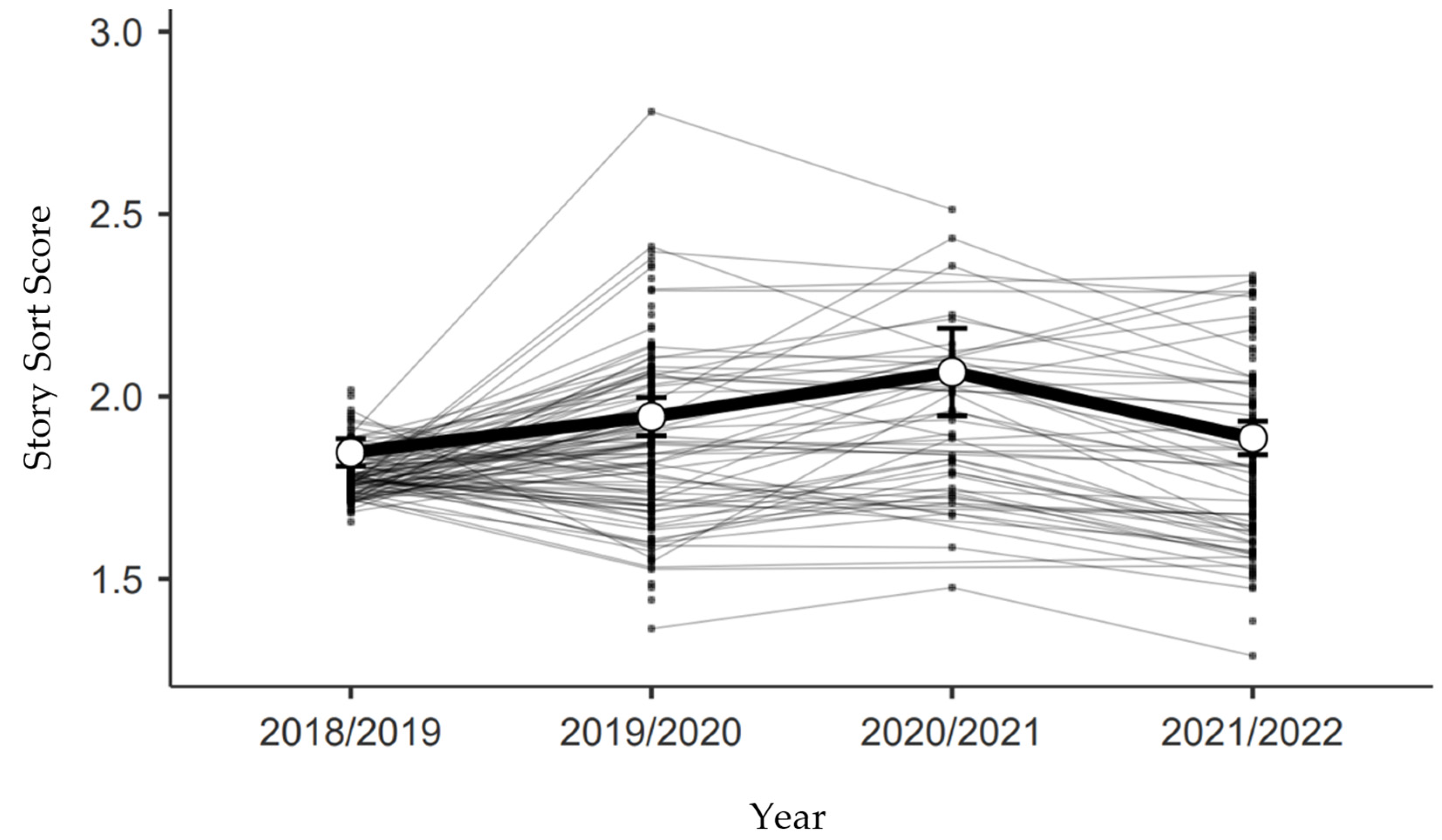
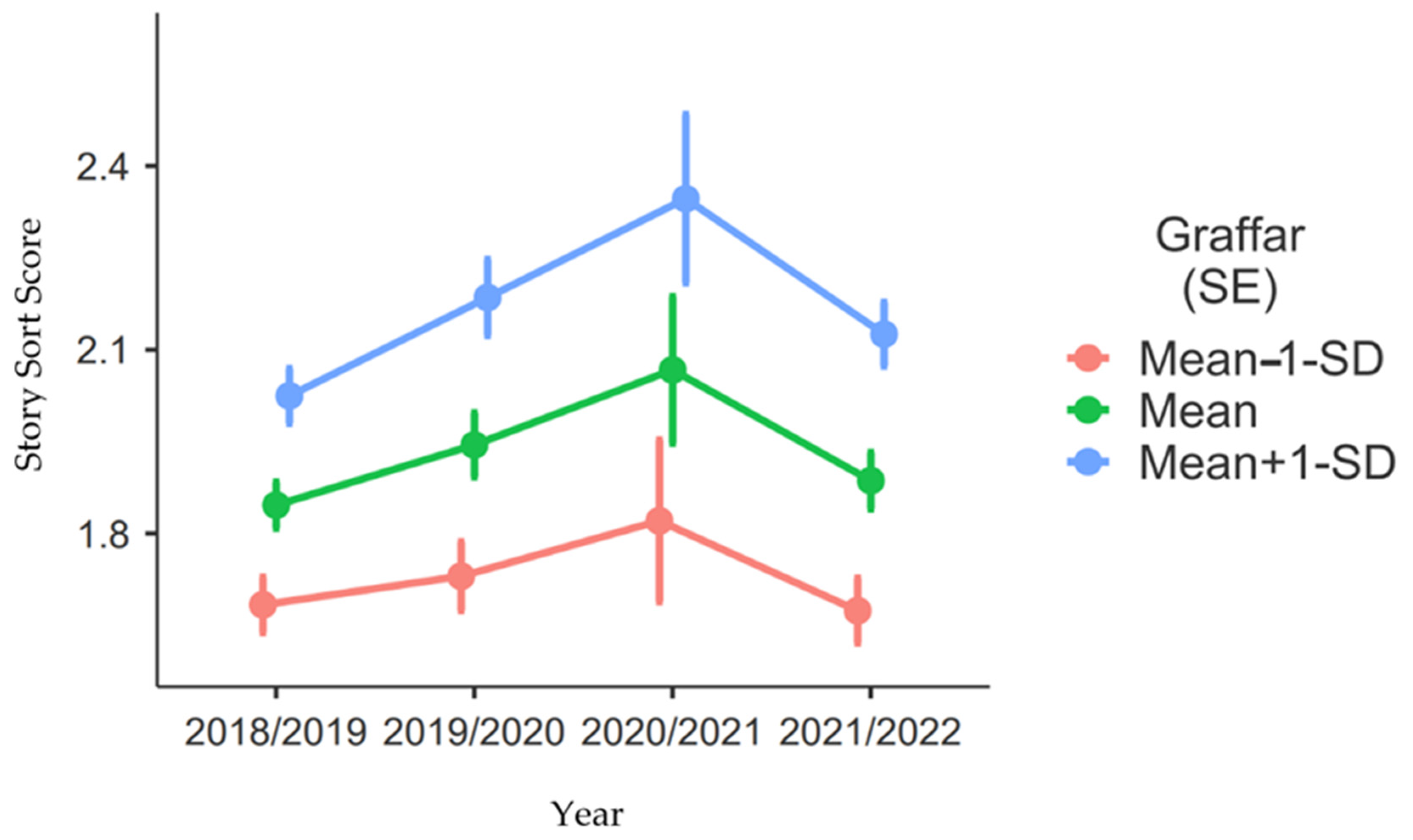
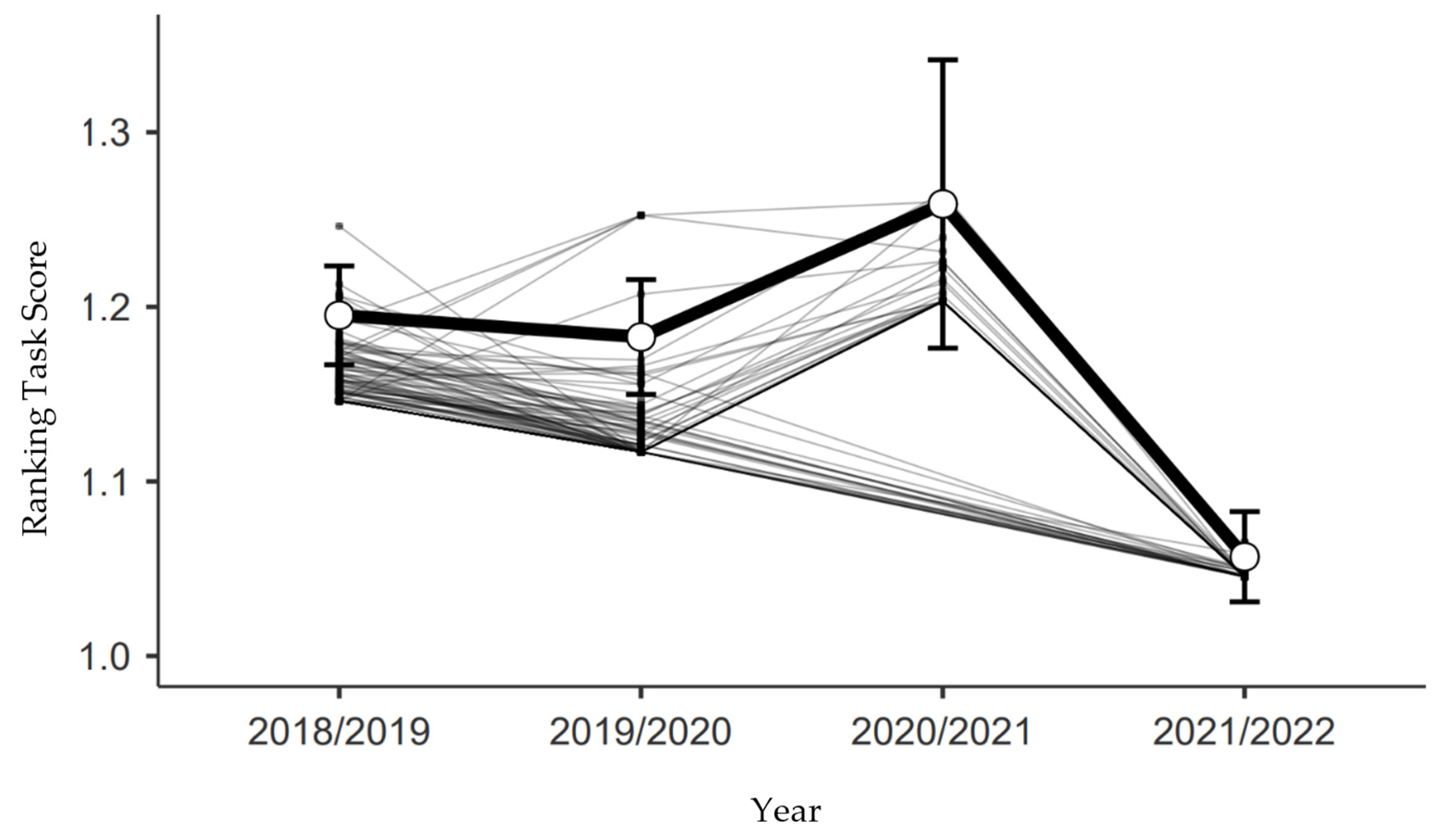
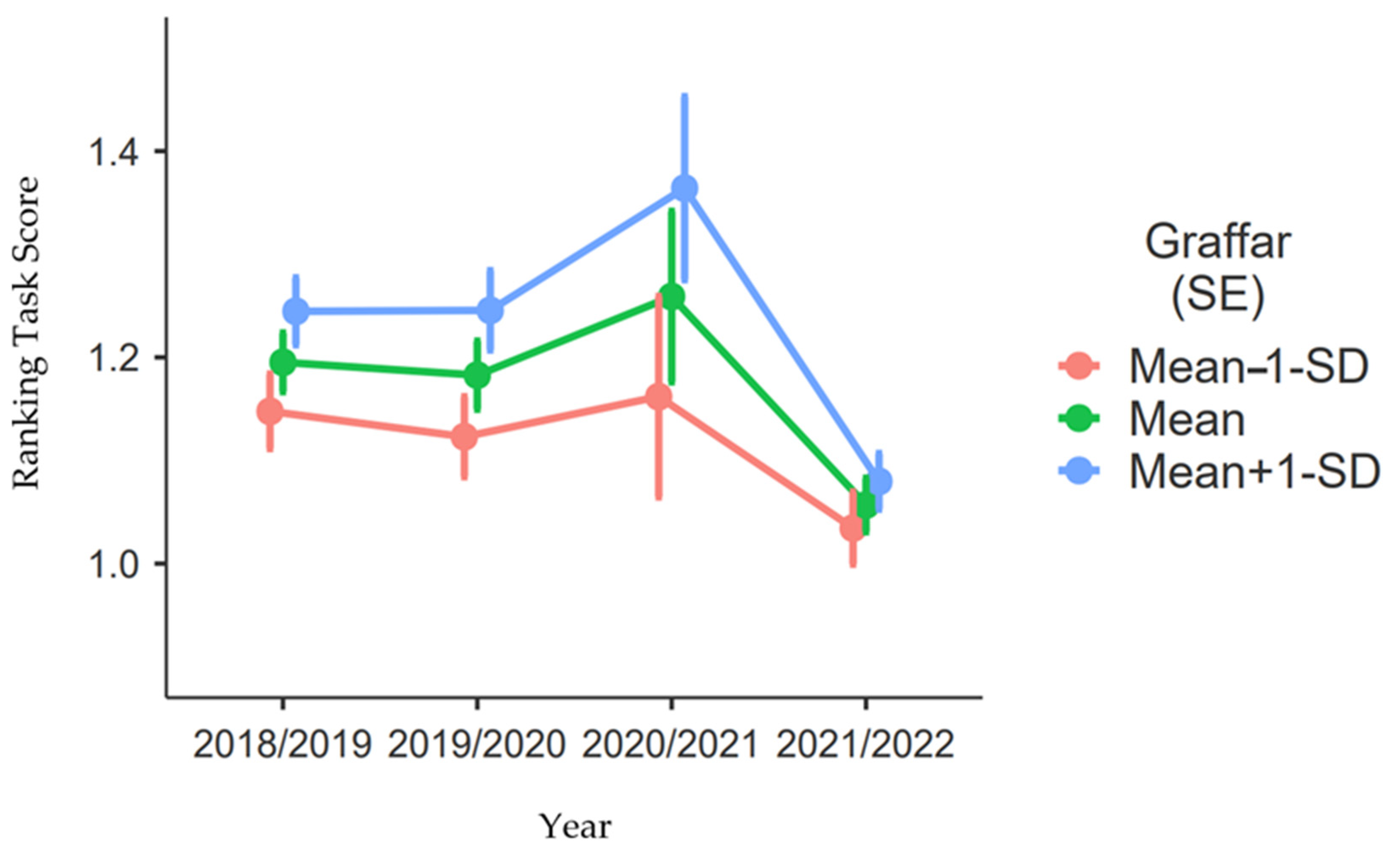

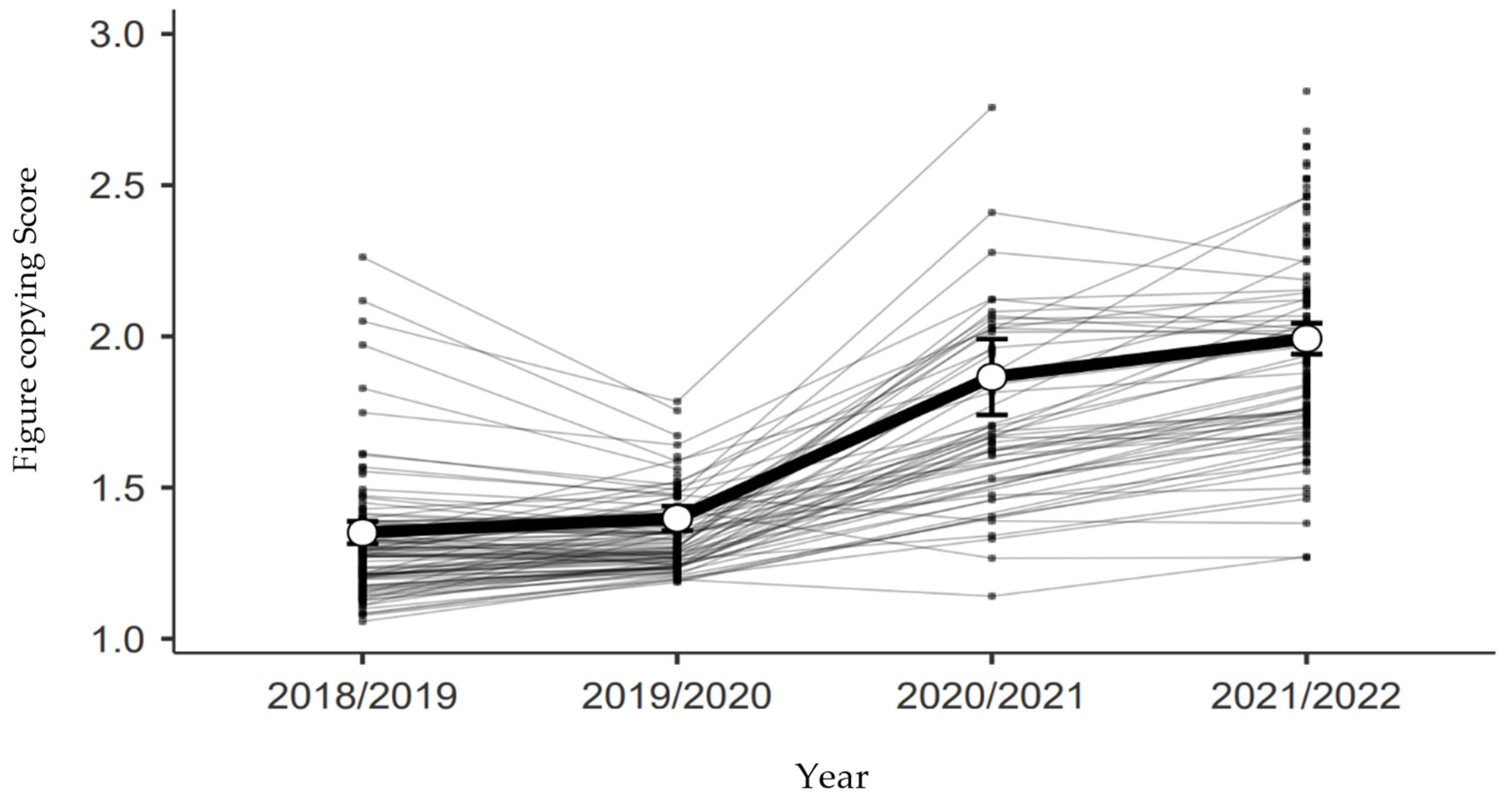
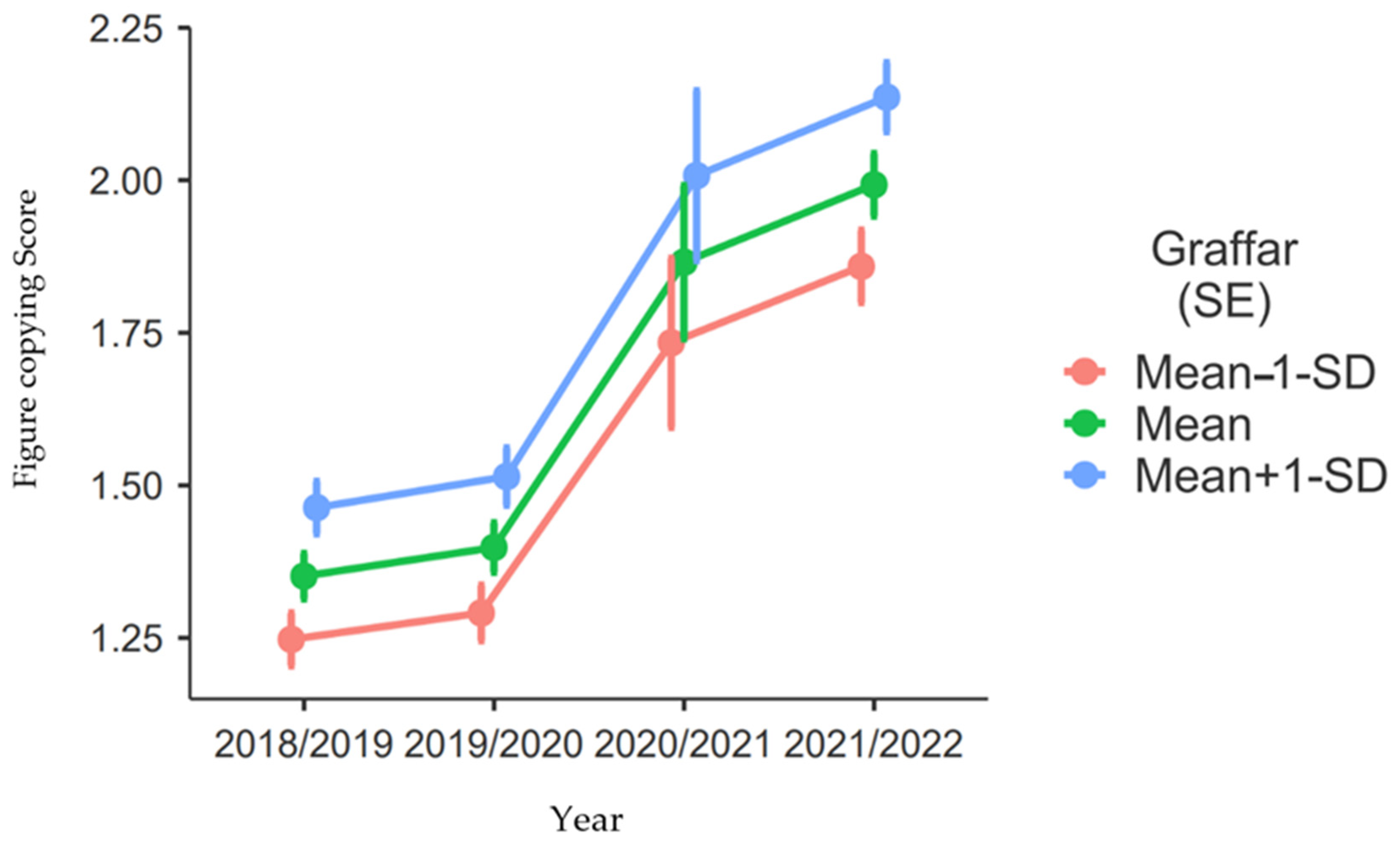
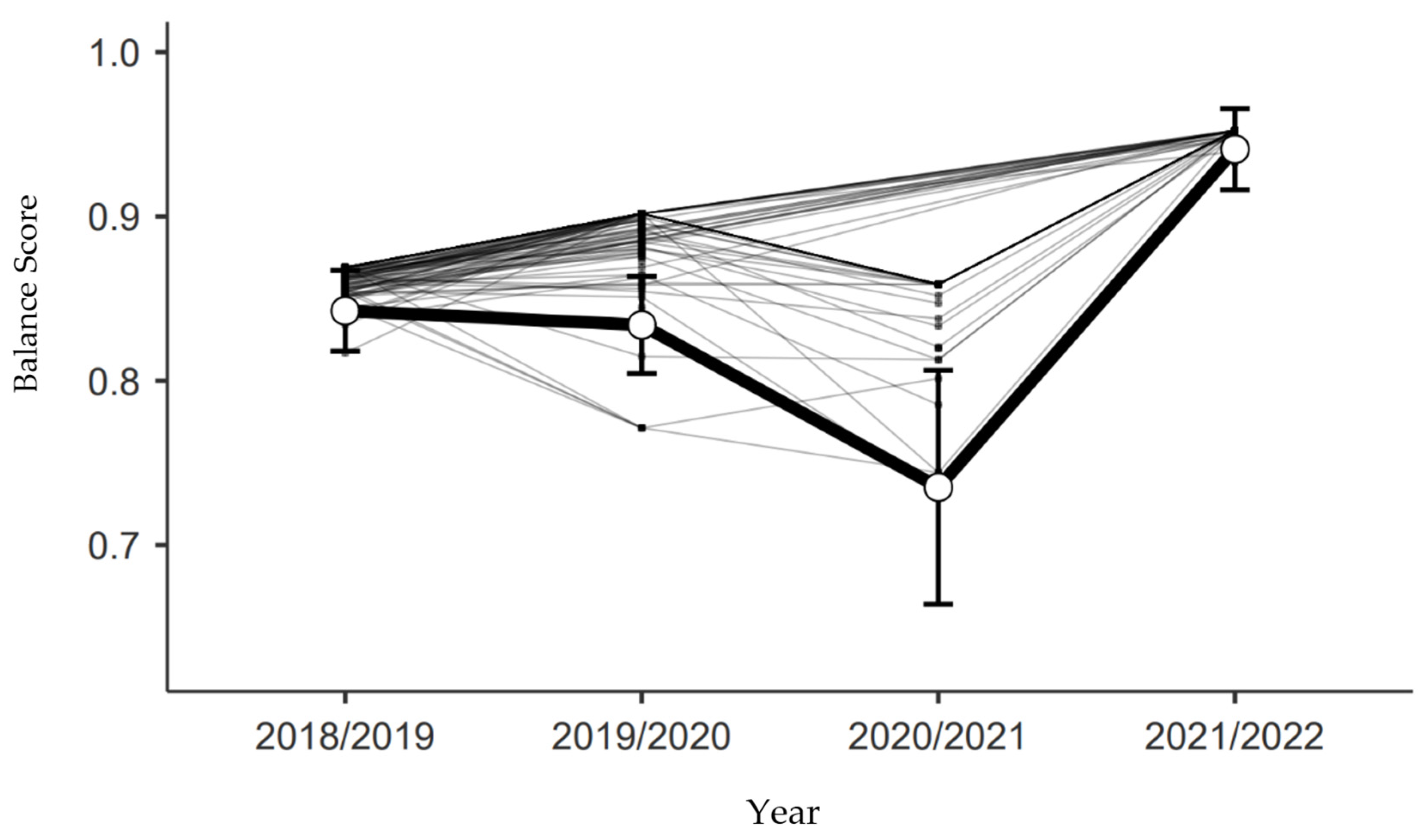

| Levels | n | % of Total | % Accumulated |
|---|---|---|---|
| 4 years | 5 | 0% | 0% |
| 5 years | 352 | 3% | 3% |
| 6 years | 9077 | 81% | 85% |
| 7 years | 1622 | 15% | 99% |
| 8 years | 88 | 1% | 100% |
| 9 years | 10 | 0% | 100% |
| 10 years | 4 | 0% | 100% |
| Levels | n | % of Total | % Accumulated |
|---|---|---|---|
| No | 1248 | 11% | 11% |
| Yes | 9910 | 89% | 89% |
Publisher’s Note: MDPI stays neutral with regard to jurisdictional claims in published maps and institutional affiliations. |
© 2022 by the authors. Licensee MDPI, Basel, Switzerland. This article is an open access article distributed under the terms and conditions of the Creative Commons Attribution (CC BY) license (https://creativecommons.org/licenses/by/4.0/).
Share and Cite
Bem-Haja, P.; Nossa, P.; Pereira, D.S.; Silva, C.F. Did the COVID-19 Pandemic Lockdown Harm Pre-Schoolers Learning in Portugal? Yes, but with Variations Depending on Socio-Economic Status. Educ. Sci. 2022, 12, 710. https://doi.org/10.3390/educsci12100710
Bem-Haja P, Nossa P, Pereira DS, Silva CF. Did the COVID-19 Pandemic Lockdown Harm Pre-Schoolers Learning in Portugal? Yes, but with Variations Depending on Socio-Economic Status. Education Sciences. 2022; 12(10):710. https://doi.org/10.3390/educsci12100710
Chicago/Turabian StyleBem-Haja, Pedro, Paulo Nossa, Diogo Simões Pereira, and Carlos F. Silva. 2022. "Did the COVID-19 Pandemic Lockdown Harm Pre-Schoolers Learning in Portugal? Yes, but with Variations Depending on Socio-Economic Status" Education Sciences 12, no. 10: 710. https://doi.org/10.3390/educsci12100710
APA StyleBem-Haja, P., Nossa, P., Pereira, D. S., & Silva, C. F. (2022). Did the COVID-19 Pandemic Lockdown Harm Pre-Schoolers Learning in Portugal? Yes, but with Variations Depending on Socio-Economic Status. Education Sciences, 12(10), 710. https://doi.org/10.3390/educsci12100710






